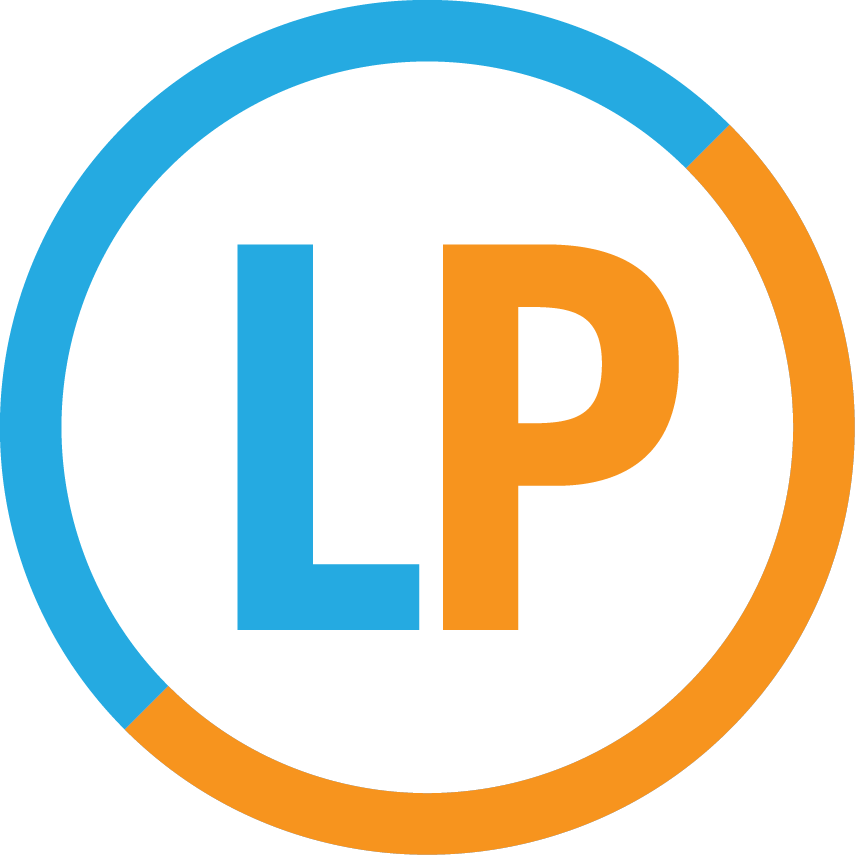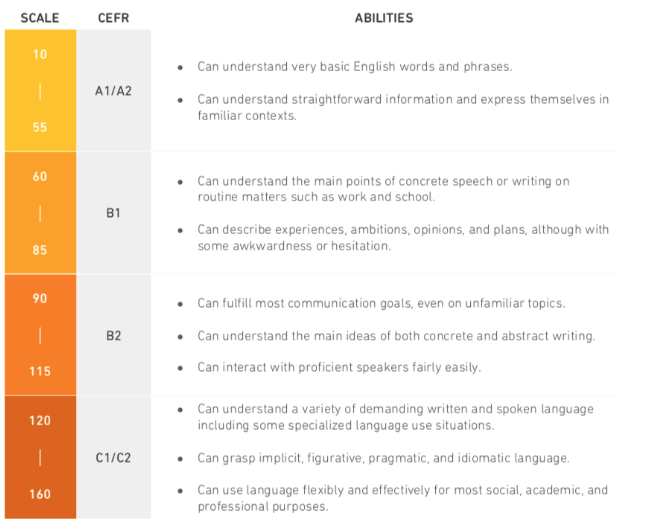At LogicPrep, we support our students every step of the way during the college application process. We are both local and global: we’re familiar with your teachers, counselors, and curriculum, yet also understand the international world of college admissions and help students around the world earn acceptance to their top choice US universities. From deciding which English proficiency test is best for you to helping you craft a compelling college narrative, our team of experts (all former college admissions officers from top universities) can guide you to success. Learn all about the Duolingo test below and contact us if you need help choosing which English proficiency test is the best for your test prep plan.
If you are a language enthusiast like I am, you might have heard of Duolingo in the past. You probably know it from its easy-to-use app designed to help users learn many different languages. You might not have heard of Duolingo’s most recent product, however: the Duolingo English Test (DET), a new English proficiency test accepted by quite a few universities (and therefore, a new competitor to the TOEFL).
What is the DET, exactly?
The DET is a computer-based, adaptive exam that measures non-native English speakers’ proficiency in English. If you’re using the DET to apply to college in the US, you may take this test as many times as you want as long as you don’t take it more than twice during a 30-day period.
What do you mean by “adaptive”?
It all has to do with how the test moves along from question to question. In an adaptive test, each question you see is based on your performance on the questions prior. For instance, as you answer questions correctly, the test presents you with more difficult ones. As long as you continue answering questions correctly, you will continue to see increasingly difficult questions. Whenever you answer a question incorrectly, the questions will return to an easier level of difficulty until you are able to answer them correctly again, and the process will continue until the end of the test.
The idea behind adaptive tests is to present you with questions that are at the right level of difficulty for your ability and therefore more precisely (and efficiently!) evaluate your proficiency than a traditional test.
What is the test like?
The test can be broken down into three sections.
Quick Setup - This includes an introduction that breaks down the rules and requirements put in place by Duolingo (not graded). (10 minutes)
Adaptive Questions - This is the bulk of the test -- the graded section where your listening, speaking, reading and writing abilities are tested. (25 minutes)
Video Interview & Writing Sample -- Here, you’ll be asked to respond to a couple of open-ended prompts. While this section is ungraded, your responses will be sent to the institutions that receive your score. (10 minutes)
Performance on test determines what questions you’ll get for Writing Sample prompts and video interview
What do the adaptive questions look like?
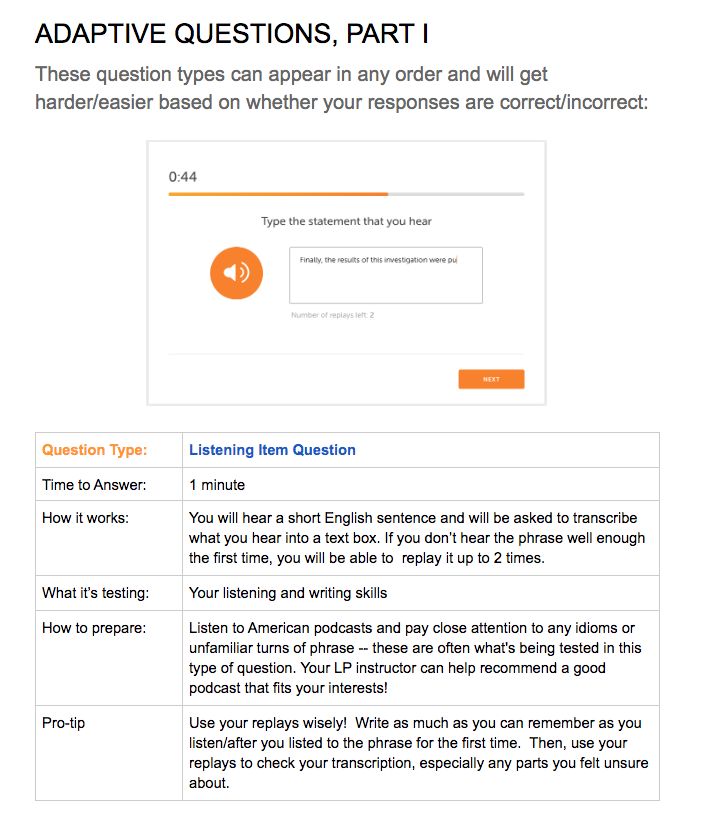
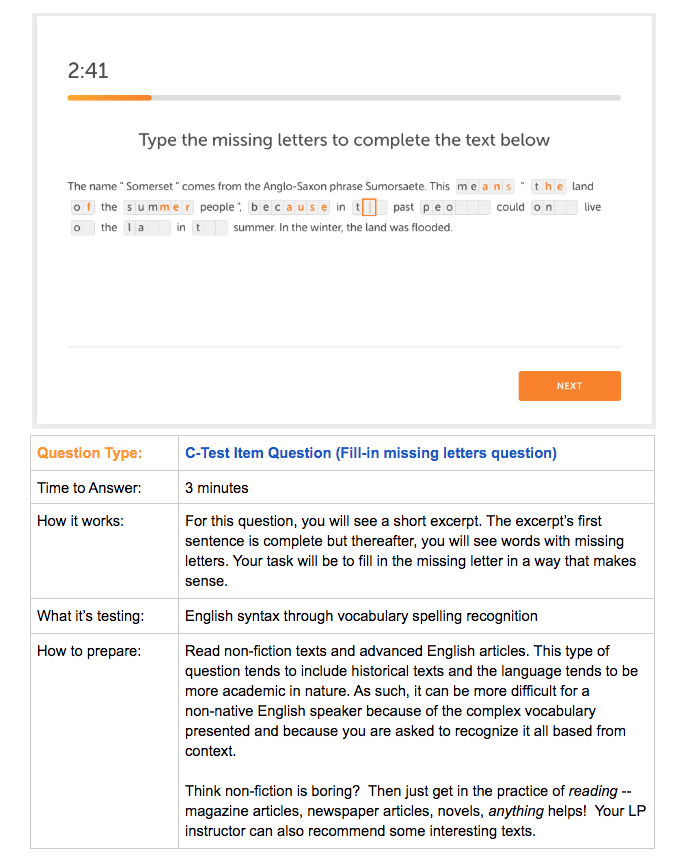
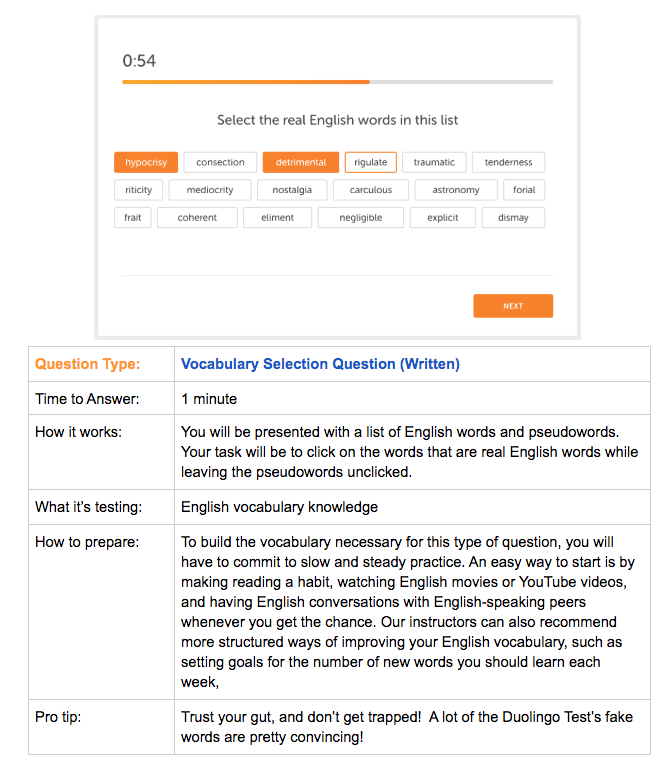
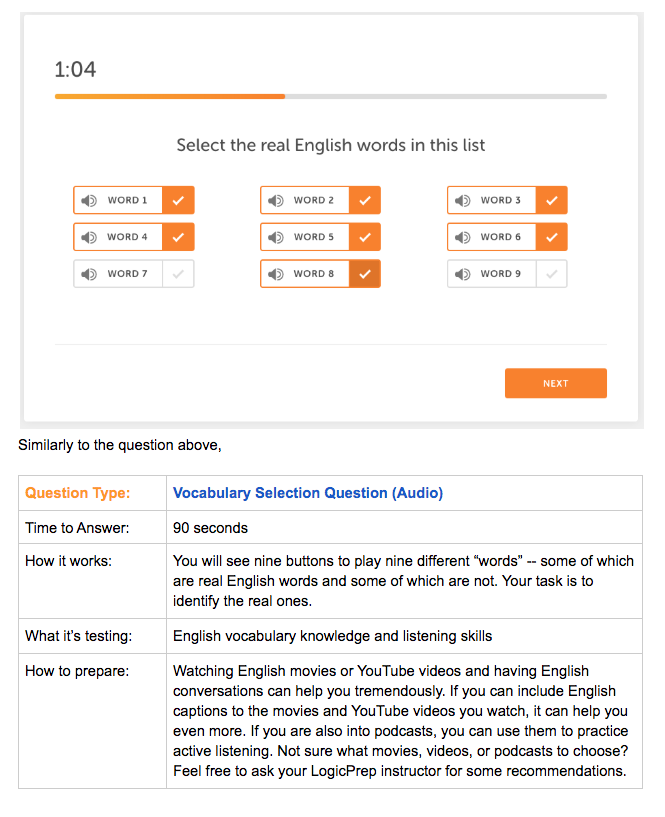
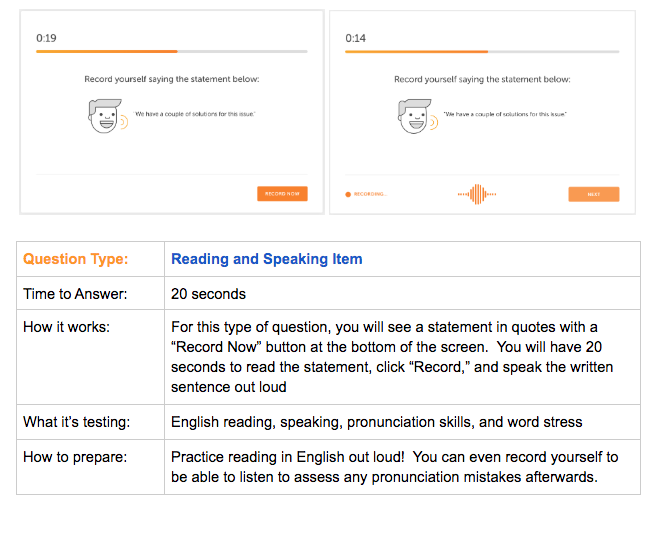
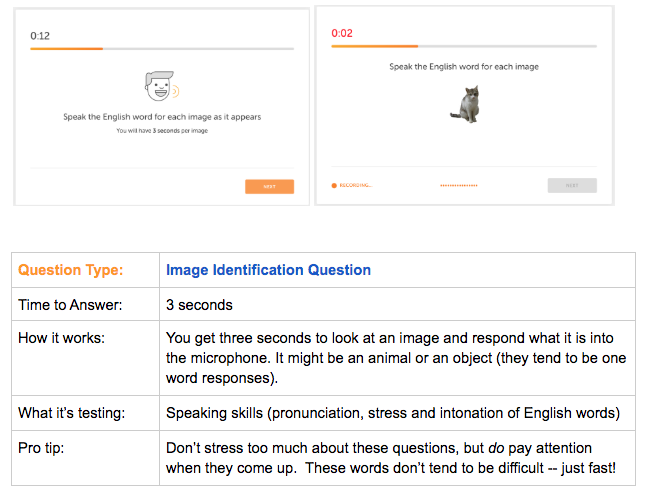
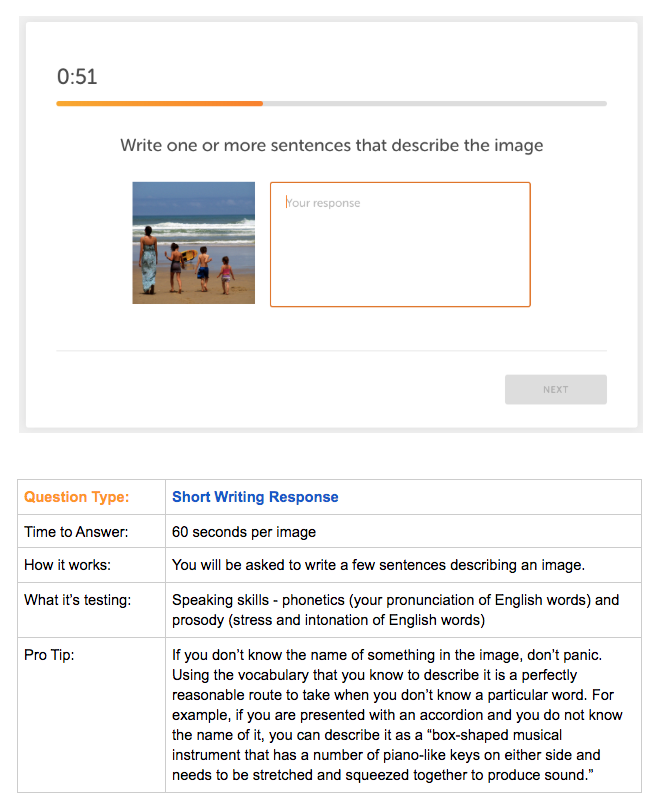
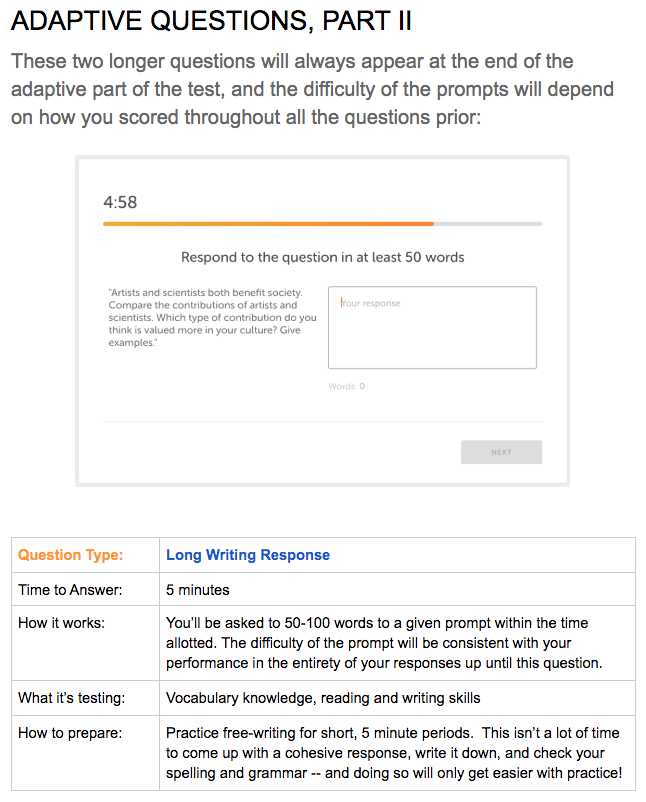
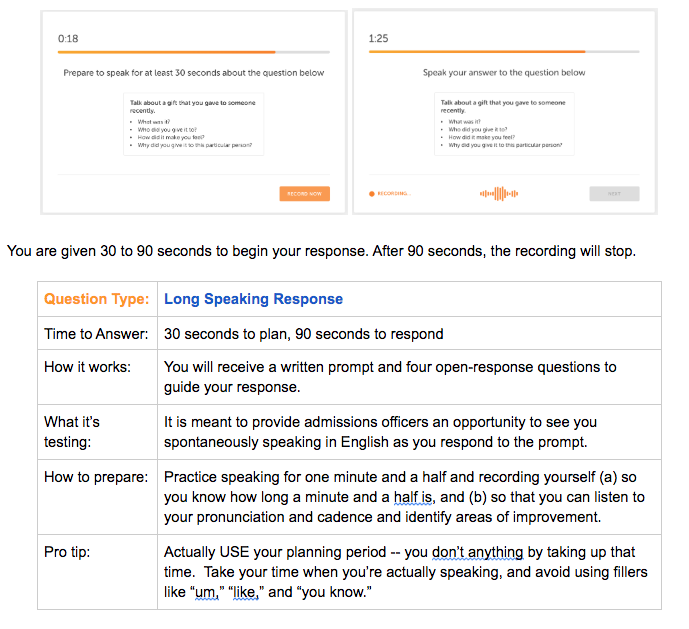
The goal of these questions is to evaluate your knowledge of English vocabulary, syntax, phonetics (your pronunciation of English words), prosody (stress and intonation of English words), reading and writing ability, and listening skills. The order in which each type of question appears is random with the exception of the last two questions: a longer written response (50 to 100 words) and speaking response (30-90 seconds).
What does the video interview and writing sample look like?
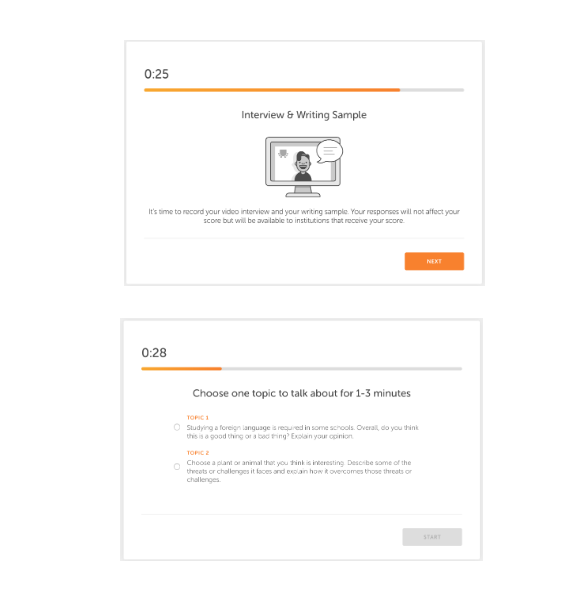
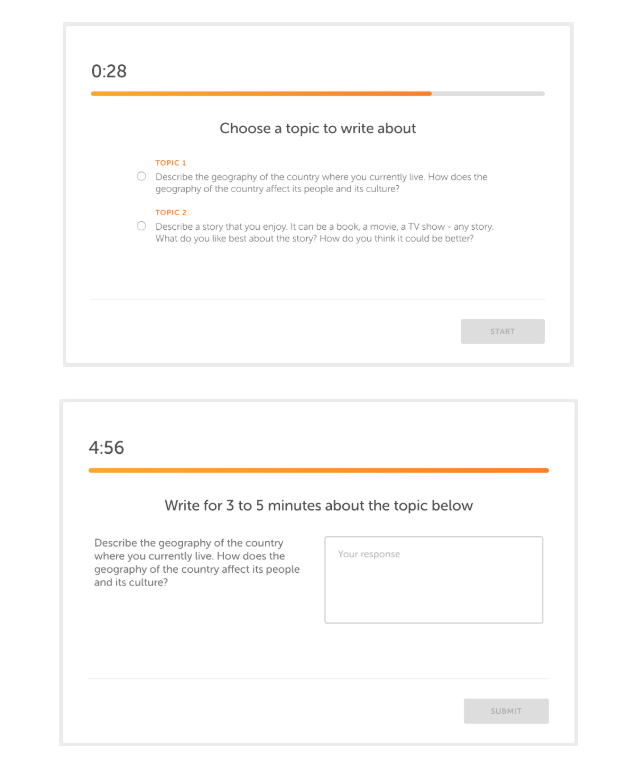
In this final part of the test, you will have two tasks: first, to verbally respond to a topic of your choosing for 1-3 minutes (while being video recorded), and second, to give a written response to a topic of your choosing in 3-5 minutes. For each task, you will have 30 seconds to read and choose your topic and plan your response.
While this section of the test is not scored, the recording and written response will be shared with the institutions that receive your score.
How is the DET scored?
The Duolingo English Test measures English language ability using a scale that ranges from 10-160 and is scored in 5 point increments. This scale is broken down into the following main categories:
If you’re curious how the DET scores compare to the TOEFL and IELTS, check out Duolingo’s Score Converter Chart.
What are the rules?
Because this is a test that you’re taking at home and Duolingo needs to protect against cheating, there are quite a lot of rules! You have to be alone in a quiet, well-lit room; your ears must be visible (not covered by hair, etc.); you can’t wear sunglasses or headphones; and you can’t use any writing utensils or paper.
While some of these rules might not seem relevant to the test, they are in place to help maintain the integrity of the test and to allow the institutions receiving your scores to have confidence in the results they receive. Duolingo has asked that you take them seriously -- so seriously that if you fail to follow some of the rules (like taking notes or using your phone during the test), you will be banned from taking it again. An extensive list of the rules is provided here.
How will Duolingo know if I have violated a rule?
The test software is able to record your screen as soon as you start the test. It also has detection protocols that will detect the moment you leave the test browser or open a new tab. All these measures will be reviewed by a remote proctor after you complete the test. If you violate a rule at any point during the test session, the remote proctor will automatically invalidate your test score.
As listed on Duolingo English Test Rules and Requirements, “Duolingo reserves the right to not certify your test results, or to invalidate any previously certified results, without providing a refund. Depending on the severity of the violation, test takers may also be banned permanently from taking the Duolingo English Test again.”
Do all colleges accept the DET?
Many institutions have adopted the Duolingo English Test as an alternative to the TOEFL including Yale, Columbia, Duke, UVA, VA Tech, John Hopkins, NYU, Wake Forest, Babson, and others. To see a full list, click here.
Ok, that was a lot of information. Big picture, what are the differences between the DET and the TOEFL?
Unlike the TOEFL, you can take the Duolingo English Test from the comfort of your home as long as you have a quiet and well-lit room with reliable internet. Before you take the test, read about all the technical requirements here.
It is cheaper ($49 USD per test versus $160-250 USD for the TOEFL, depending on your country), and you may share your scores with an unlimited amount of colleges at no additional cost (for the TOEFL, every score report you want to send after the first four costs an additional $20).
The test only takes 45 minutes to complete, whereas the TOEFL takes about 3 hours.
You receive your score within 48 hours of taking the DET, as opposed to approximately 10 days for the TOEFL.
You may take the DET as many times as you want as long as you don’t take it more than twice during a 30-day period. Meanwhile, you can retake the TOEFL as many times as you wish, as long as you don’t take it more than once in a 3-day period.
The DET includes a video interview question at the end that allows admissions officers to see and hear you spontaneously speaking in English as you respond to the prompt. This allows you to avoid doing an additional English proficiency interview that some admissions offices will require.
Can I take a practice test before I take the real DET?
On Duolingo’s website, you have the opportunity to try a sample test, which you should definitely take multiple times so that you can experience the various types of adaptive questions live. After you go through some of the questions, you’ll notice some of the same types of questions you saw at the beginning of the test begin to repeat themselves. A timer on the top left-hand side of each question will help you maintain your pace. Keep in mind that the sample test is much shorter than the real DET – only 15 minutes instead of 45 – and that while you can obtain an estimated score from this sample test, it is not entirely accurate because the sample test pulls from a much smaller pool of questions than the real one.
A new test might sound intimidating, but you can also see it as another option for proving your English proficiency to colleges (and as a new opportunity for learning!). The exciting part of this is that you can choose which test fits you best– the TOEFL, DET, or IELTS. Our team of Advisors is here to help you decide which ESL test is best for you, and our tutors are here to help you get started. Just reach out today to learn more!
